Session one Shaping sound focused on how the University is using sound waves to create touch. Sound is made of pressure waves. In their applications, they use sound waves to create the feeling of touch or to levitate objects. To achieve these effects, however, they first need to shape the sound. They do this by working with many small speakers (i.e. an array of speakers) and by controlling the moment sound leaves each one of them:
- They use 40 kHz: a frequency that dogs, bats or dolphins can hear, but that humans cannot.
- In Figure 1, they switch all the speakers ON and OFF at the same time. The waves arrive at the hand above and no effect is felt.
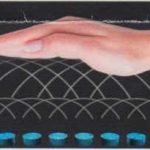
- If they turn the speakers ON and OFF at very specific times (Figure 2), then the waves will collide to construct a strong “red” focal point at the hand. This is how they create a touch sensation!
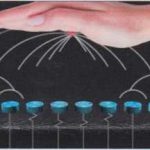
- In the HapticTactics and in Kitchen2017, a sensor tracks the hand and adjusts the timing of the speakers, so that the user can feel invisible controls while gaming or in everyday life.
- In Figure Me Out! the speakers are used to create multiple spots on the hand, so that the user can feel an invisible shape. Tactile experiences like this can be used in virtual reality settings or to transmit touch over distances – the next step for Skype?
- They also control waves as they come out of the speakers in their Levitation Acoustic levitation can be used in chemical analysis, in art installations, to create novel interactive experiences.
- Controlling the speakers electronically may be expensive. An alternative is to add in front of them a specially engineered material (i.e. a meta-material) to create the desired delays. At the INTERACT lab they build metamaterials in the shape of bricks, that they assemble to create acoustic lenses or mirrors (Figure 3).
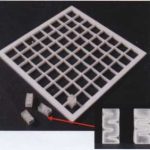
They are working on a meta-material sleeve that will make directional any type of loudspeaker, improving audio experiences in supermarkets and cinemas, creating acoustic shapes on top of smartphones and tablets, but also reducing the costs associated to other ultrasound-based applications in medicine and industry.
The students found the figure me out game interesting; trying to guess the shape from the way the sound felt:
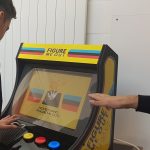
The second device was a game controlled by sound the game had been created in Unity.

The interesting thing is that the sound can’t be heard by human ears but recorded the sound shows up:
INSERT VIDEO
Students also got to play with sound levitation; they spent time talking about the application of sound to transport objects and produce shapes:
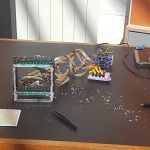
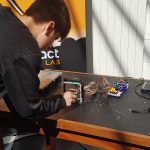
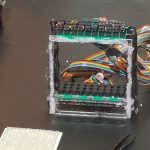
The afternoon session focused on the programming of a Freedom-K64F (ARM® Cortex®-M4) microcontroller :
The Flagship FRDM-K64F has been designed by NXP in collaboration with mbed for prototyping all sorts of devices, especially those requiring optimized size and price points. The board is well sized for connected applications, thanks to its power efficient Kinetis K64F MCU featuring an ARM® Cortex®-M4 core running up to 120MHz and embedding 1024KB Flash, 256KB RAM and lots of peripherals (16-bit ADCs, DAC, Timers) and interfaces (Ethernet, USB Device Crystal-less and Serial). The Kinetis K64 MCU family remains fully software, hardware and development tool compatibility with Kinetis MCU and Freedom board families. It is packaged as a development board including extension headers compatible with Arduino R3 shields and includes a built-in USB Debug and Flash Programmer.
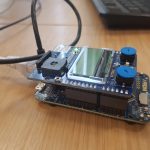
The students worked hard and once they had got Snake running they adapted the code to to make it longer and add lives this was impressive as they have only learnt python but applied the skills to adapt the C++ code.
INSERT VIDEO
A massive thanks to the team as Sussex University for making it a fantastic day.
]]>